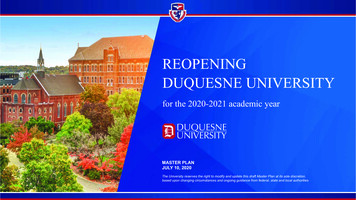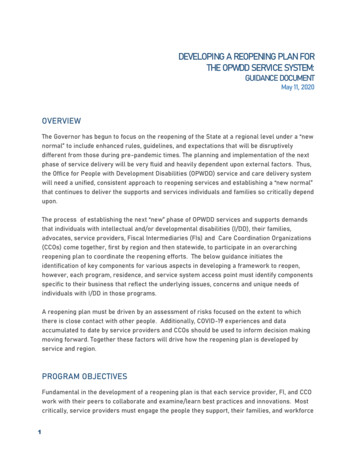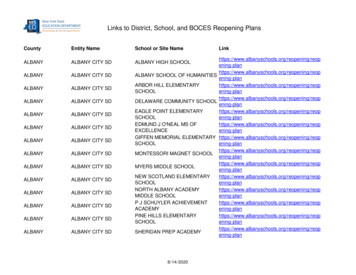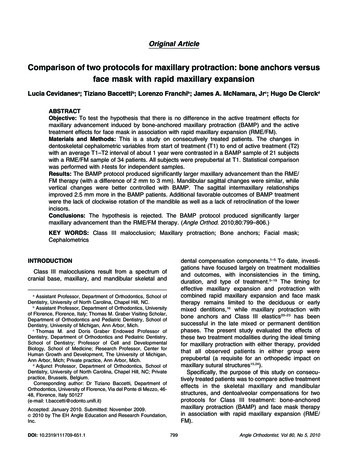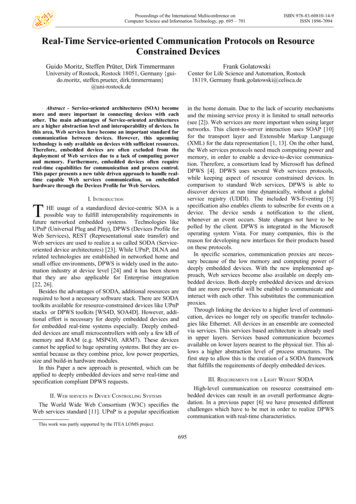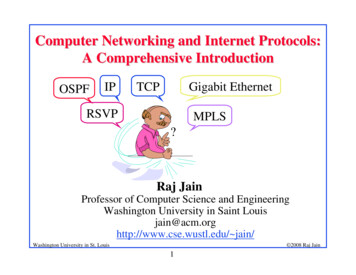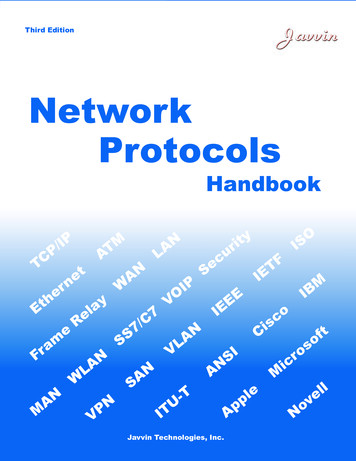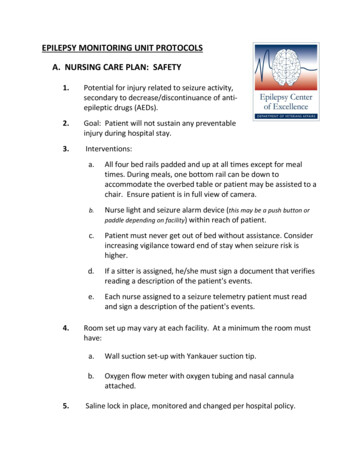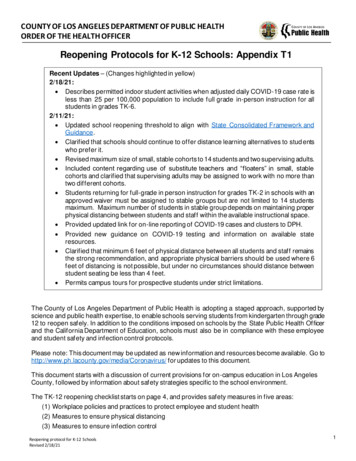
Transcription
COUNTY OF LOS ANGELES DEPARTMENT OF PUBLIC HEALTHORDER OF THE HEALTH OFFICERReopening Protocols for K-12 Schools: Appendix T1Recent Updates – (Changes highlighted in yellow)2/18/21: Describes permitted indoor student activities when adjusted daily COVID-19 case rate isless than 25 per 100,000 population to include full grade in-person instruction for allstudents in grades TK-6.2/11/21: Updated school reopening threshold to align with State Consolidated Framework andGuidance. Clarified that schools should continue to offer distance learning alternatives to stud entswho prefer it. Revised maximum size of small, stable cohorts to 14 students and two supervising adults. Included content regarding use of substitute teachers and “floaters” in small, stablecohorts and clarified that supervising adults may be assigned to work with no more thantwo different cohorts. Students returning for full-grade in person instruction for grades TK-2 in schools with anapproved waiver must be assigned to stable groups but are not limited to 14 studentsmaximum. Maximum number of students in stable group depends on maintaining properphysical distancing between students and staff within the available instructional space. Provided updated link for on-line reporting of COVID-19 cases and clusters to DPH. Provided new guidance on COVID-19 testing and information on available stateresources. Clarified that minimum 6 feet of physical distance between all students and staff remainsthe strong recommendation, and appropriate physical barriers should be used where 6feet of distancing is not possible, but under no circumstances should distance betweenstudent seating be less than 4 feet. Permits campus tours for prospective students under strict limitations.The County of Los Angeles Department of Public Health is adopting a staged approach, supported byscience and public health expertise, to enable schools serving students from kindergarten through grade12 to reopen safely. In addition to the conditions imposed on schools by the State Public Health Officerand the California Department of Education, schools must also be in compliance with these employeeand student safety and infection control protocols.Please note: This document may be updated as new information and resources become available. Go tohttp://www.ph.lacounty.gov/media/Coronavirus/ for updates to this document.This document starts with a discussion of current provisions for on-campus education in Los AngelesCounty, followed by information about safety strategies specific to the school environment.The TK-12 reopening checklist starts on page 4, and provides safety measures in five areas:(1) Workplace policies and practices to protect employee and student health(2) Measures to ensure physical distancing(3) Measures to ensure infection controlReopening protocol for K-12 SchoolsRevised 2/18/211
COUNTY OF LOS ANGELES DEPARTMENT OF PUBLIC HEALTHORDER OF THE HEALTH OFFICER(4) Communication with employees, students and families of students and the public(5) Measures to ensure equitable access to critical services.These five key areas must be addressed as your facility develops any reopening protocols. Schools mustimplement all applicable measures listed below and be prepared to explain why any measure that is notimplemented is not applicable to the setting.Special guidance for the TK-12 settingWhen Adjusted Daily COVID-19 Case Rate is greater than 25 per 100,000 population:TK-12 schools in Los Angeles County may open for remote learning. Schools in California may not reopen forin-person instruction for grades 7-12 if the county is in Tier 1 (Purple Widespread). Schools serving students ingrades TK-6 may not reopen for in-person instruction in counties with an adjusted daily case rate above25 per 100,000. Limited exceptions to this prohibition are described below. Aside from these exceptions,TK-12 schools in Los Angeles County may open only for remote learning. During this period, employees,and staff, as defined below, may report to school campus for work in order to support essential operations,implement remote learning or conduct one of the permitted exceptions for on-campus student services orinstruction. Schools offering on campus learning opportunities should also continue to offer 100%distance learning opportunities to families that prefer it. Student activities permitted on campus are: Day care for school-aged children and/or child care programs located in schools.o LEAs and schools that offer day care services for children at schools must be in compliance withthe DPH protocol for Programs Providing Day Care for School-Aged Children or the Guidance forECE Providers. Programs that wish to provide day care for school aged children at schools shouldcommunicate with their Community Care Licensing Regional Office to inquire regarding theavailability of waivers for licensed child care facilities and license-exempt providers due to COVID19. For additional information see PIN 20-22-CCP.o Schools that provide child care programs for school-aged children on their campus must file thenotification for Child Care Services for School-aged Children on K-12 School sites with LAC DPH. Specialized services for defined subgroups of children who need in person services andsupports.o LEAs and schools are not required to provide specialized, in-person services, but those that do somay serve students with IEPs, students who are English Language learners, and students withneeds that cannot be met through a virtual instruction platform. These students may be served asneeded, provided that the overall number of students present on -site does not exceed 25% of totalstudent body at any one time. An exception to this 25% rule is schools that have received a waiverto return students in grades TK – 2 for in person instruction. Schools that have received a waiverare permitted to bring all students in grades TK – 2 back to campus including high need studentsin those grades. In that situation, the school may also bring up to 25% of total stud ent enrollmentin grades 3 and above at any one time for specialized support and services for high need studentsin those grades, as long as the school can adhere to distancing, infection control, and cohortingrequirements.o Specialized services may include but are not limited to occupational therapy services, speech andlanguage services, other medical services, behavioral services, educational support services aspart of a targeted intervention strategy, or assessments, such as those related to English Learnerstatus, Individualized Education Plans, and other required assessments.o No child may be part of more than one cohort. Students who are part of a cohort may leave thecohort for receipt of additional services. Any additional services, however, must be provided oneon-one by the appropriate specialist in a secure space that is apart from all other people.o Schools must agree to cooperate with DPH with regard to screening, monitoring andReopening protocol for K-12 SchoolsRevised 2/18/212
COUNTY OF LOS ANGELES DEPARTMENT OF PUBLIC HEALTHORDER OF THE HEALTH OFFICERdocumentation that will be required to permit careful scrutiny of h ealth outcomes associated withthis initial period of expansion.o To the extent consistent with specialized needs of students in a given cohort, use of outdoor spacefor at least 50% of the school day is strongly encouragedo LEAs and schools that choose to implement these on-site services for students with specializedneeds, must inform the Los Angeles County Department of Public Health of their plans prior tostart of services. If a school has already been approved for a waiver to reopen for stude nts ingrades TK – 2, the school still is required to file a notification to provide services to students withspecial needs if the school intends to bring students back to campus in addition to those in gradesTK – 2. A reporting form can be found at Small Group Instruction Notification Form.o Further information from the State concerning specialized services may be found at SpecializedSupport and Services. Supervised administration of college admission tests, including PSAT, ACT, and SAT exams.o College admission tests, including PSAT, ACT, and SAT exams, may be conducted at schools aslong as students are appropriately cohorted for the entire duration of the assessment (no morethan 14 students in each classroom with a distance of at least 6 feet between students andbetween students and teachers.o All students and staff are wearing face masks for the entire time on campus, infection controldirectives are in place.o There is no gathering at arrival and dismissal times or during test breaks. On-site instruction of children in grades TK-6 by schools that have been opened for full gradein-person instruction at any point when the adjusted daily case rate was less than 25 per100,000 population.o Any school that has been approved by the State Safe Schools for All Team and LACDPH, whetherthrough automatic expansion of an existing elementary school waiver, or through the full COVID19 Safety Plan submission and review process, AND has actually opened for full grade in personinstruction for students in any grade TK-6 when the adjusted daily case rate was below 25 per100,000 population, may remain open for grades TK-6 even if the case rate subsequently risesabove 25 per 100,000 population again.o Students in grades TK-6 returning for general in-person instruction must be assigned to stablegroups that maintain stable membership of students and instructors day to day and do not mixwith other stable groups. The size of these stable groups is not limited to a specific maximumnumber but is dependent on utilization of the available classroom space to allow physicaldistancing of 6 feet between all students and staff.When Adjusted Daily COVID-19 Case Rate has been less than 25 per 100,000 population for at least 5consecutive days: Schools may open for full grade in-person instruction for students in grades TK-6 when the adjusteddaily case rate has been less than 25 per100,000 population for 5 consecutive days and the schoolhas met all state and county requirements for opening.o Students in grades TK-6 returning for general in-person instruction must be assigned to stablegroups that maintain stable membership of students and instructors day-to-day and do not mixwith other stable groups. The size of these stable groups is not limited to a specific maximumnumber but is dependent on utilization of the available classroom space to allow physicaldistancing of 6 feet between all students and staff. The other student services described above, namely day care for school-aged children and/or childcare programs; specialized services for defined subgroups of children; and supervised administrationReopening protocol for K-12 SchoolsRevised 2/18/213
COUNTY OF LOS ANGELES DEPARTMENT OF PUBLIC HEALTHORDER OF THE HEALTH OFFICERof college admissions tests, are also permitted when the adjusted daily case rate is less than 25 per100,000 population, subject to the same parameters and limitations described above for each service.All measures to ensure the safety of employees and students in this protocol for Reopening of TK-12Schools and in the associated protocol for K-12 Exposure Management must be implemented and areapplicable to all on-site personnel, including those providing specialized services. The followingparagraphs highlight safety strategies specific to the school environment. Additional resources for K-12Schools can be found in the TK-12 School COVID-19 Toolkit.COHORTINGFor the three types of on-site programming that are permitted at all schools (day care for school-agedchildren, specialized services for defined subgroups of children, and administration of college admissiontests), students must be organized and proceed through the day within small cohorts, defined as stablegroups of no more than 14 children or youth and no more than two supervising adults in a supervisedenvironment in which supervising adults and children stay together for all activities (e.g., meals, recreation,etc.), and avoid contact with people outside of their group in the setting. Note that if a cohort has fewer than 14 children or if a child stops attending a previously full cohortother children who are not already assigned to a cohort can be added to the group to reach themaximum of 14, provided all the children, once assigned remain with the same cohort at all times.If some children are assigned to a stable cohort but only attend part-time, they must be countedas full members against the maximum of 14. Part-time members cannot “share” their slot with otherpart-time students. Other children cannot be added in order to reach the maximum of 14participants at all times.Aides assigned to individual children do not have to be counted as supervising adults. They must,however, be counted against the maximum of 16 individuals who can be included in a cohort.Supervising adults may be assigned to work with two different cohorts if the two cohorts are presentat school on different days of the week or different sessions during the day, for example an AMand PM session. Assignment to more than two cohorts is not permitted.Deployment of substitute providers who are covering for short-term absences is allowed, but theymust work with no more than 2 cohorts of children per day. Essentially, the substitute will adoptthe assignment of the absent employee for whom they are covering and work exclusively with thesame cohort(s) to which the permanent employee is assigned.“Floaters,” who cover for supervising adults during the day for employee breaks, may constitute athird supervising adult in the cohort, but may not provide coverage for more than two differentcohorts during a day and should be spending limited time with any one cohort as needed to providecoverage for the permanently assigned supervising adults.Important additional details for implementation of cohorts are available from the CA Department of PublicHealth Guidance Related to Cohorts.For instruction of children in grades TK-6 where permitted, instruction must be provided in stable groups,however the size of such groups are not limited to 14 students and 2 supervising adults. The size of thestable group must be set to allow for appropriate physical distancing between all students and staff at alltimes in the available instructional space.LIMITED ON-CAMPUS DENSITYWhile Local Education Agencies (LEAs) or schools may configure as many cohorts as are appropriate tomeet student needs for specialized services, the total on-campus population may not exceed 25% of thetotal student body at any one time for this particular purpose. The 25% limit does not apply to school agechildren on campus receiving day care while engaged in distance learning activities, nor does it apply toReopening protocol for K-12 SchoolsRevised 2/18/214
COUNTY OF LOS ANGELES DEPARTMENT OF PUBLIC HEALTHORDER OF THE HEALTH OFFICERstudents in grades TK - 2 returning after granting of a school waiver. Schools that have been granted awaiver to return students in grades TK - 2 may bring additional students onto campus for specializedservices in grades above grade 2 but not up to 25% of total student enrollment. If the school has beengranted a waiver for grades TK – 2, schools may bring additional students onto campus for specializedservices and assessments up to a maximum of 25% of student enrollment in grades 3 and above, as longas the school can adhere to distancing, infection control, and cohorting requirements.SUPERVISING ADULTSA supervising adult is an adult assigned to one cohort of children or youth, who does not phy sically interactwith any other cohorts. Supervising adults may be child care staff, certificated or classified school staff,volunteers, participating parents or caregivers, or other designated supervising adult(s). An aide who ispresent to provide support to an individual child should be counted as a member of the cohort but not asa supervising adult. A supervising adult may be assigned to 2 different stable cohorts if they offerspecialized services/support that cannot be provided by any other supervising adult.SUPERVISED ENVIRONMENTSA supervised care environment is an environment where multiple children or youth, from multiple familiesor households, are supervised simultaneously by an adult. This includes, but is not limited to, licensedchild care facilities, licensed exempt child care programs, supervised programs on a school site while aschool is not in session or is providing curriculum in a distance-learning format, or where some educationalservices are being offered to a subgroup of students defined by a local educational agency on a school.TK to Grade 12 Reopening ChecklistInstitution name:Holy Family High SchoolAddress:400 E. Lomita Ave., Glendale, CA 91205Maximum Occupancy, per Fire Code: 821Approximate total square footage ofspace open to faculty and/or31,139 square feetstudents:Estimated total number of administrators, teachers, and other employees that will be returning tosupport resumption of all permitted in person services for students:Estimated total number of students that will return per grade (if none, enter 0):TK:0K:01: 02:06:07:08: 09: 223:04:05:25251810:11:12:NOTE: The terms “employees” and “staff” are used in these protocols to refer to individuals who work ina school facility in any capacity associated with teaching, coaching, student support, provision of therapiesor personal assistance to individual students, facility cleaning or maintenance, administration, or any otheractivity required for the school to function. “Employees” or “staff” may include individuals who are: paiddirectly by the relevant school system, paid by entities acting as contractors to the school, paid by outsideentities acting in collaboration with the school to serve students, paid by third parties to provide individualstudent services, or unpaid volunteers acting under school direction to carry out essential functions. Theterm “parents” is used in these protocols to refer to any persons serving as caregivers or guardians toReopening protocol for K-12 SchoolsRevised 2/18/215
COUNTY OF LOS ANGELES DEPARTMENT OF PUBLIC HEALTHORDER OF THE HEALTH OFFICERstudents.A. WORKPLACE POLICIES AND PRACTICES TO PROTECT STAFF (“EMPLOYEES”) ANDSTUDENTS (CHECK ALL THAT APPLY)The school has a COVID-19 Containment, Response and Control Plan that describes the school’scomprehensive approach to preventing and containing the spread of COVID-19 on campus. The Planincludes, but is not limited to the following elements: X A designated COVID-19 Compliance Team that is responsible for establishing and enforcing allCOVID-19 safety protocols and ensuring that staff and students receive education about COVID19. One member of this team is designated as a liaison to DPH in the event of an outbreak oncampus.X A plan or protocol, for steps that will be taken immediately upon notification of school officials that any member of the school community (faculty, staff, student, or visitor) tests positive for COVID-19.The plan addresses:oImmediate separation of the case from the school community to self -isolation at home ifnotification occurs while the case is on-site. The plan must allow for temporary, on-siteisolation of the case if arrangements are needed for the person’s return to their home.oFactsheets or other informational materials that are to be given to the case (or appropriatefamily member/s if the case is a child) covering regulations governing self-isolation and links tosites with further information.X A plan or protocol to initiate a School Exposure Management Plan consistent with DPH guidance that outlines procedures for:oooIsolation of case(s);Identification of persons exposed to cases at school;Immediate quarantine of exposed employees and/or students; andoAssurance of access to testing for all expos
TK-12 schools in Los Angeles County may open for remote learning. Schools in California may not reopen for in-person instruction for grades 7-12 if the county is in Tier 1 (Purple Widespread). Schools serving students in grades TK-6 may not reopen for in-person instruction in counti
